I’ve recently been reading Studs Terkel’s Pulitzer Prize winning The Good War: An Oral History of World War Two. Terkel interviewed dozens of people from all of the proverbial walks of life, gathering their reminiscences of the war. I was struck by the frequency of a particular observation offered by many of his interviewees who had been overseas during the war: that if anything like London, Dresden, or Hiroshima had ever happened in the U.S., Americans would not be so quick on the trigger when committing to military action and/or declaring war.
When I was an historian with the Maryland Park Service I wrote, produced, and narrated a couple of short video presentations about the Battle of South Mountain (fought on September 14, 1862 as part of Lee’s Maryland Campaign); these were displayed in the park museum. I found it necessary to include a slide in one of them which illustrated the devastation of war to reinforce the point that Lee wanted to get the war out of Virginia and move it northward because of the widespread destruction which was taking its toll on Virginia’s farms and businesses. You’d be amazed how many of my visitors thought that battles were fought in big empty fields by some pre-arrangement made by the commanders, and that war didn’t really touch common citizens in a very real and visceral way. I attribute this misapprehension to two main causes: the “sanitizing” of the Civil War in the decades since its end (and I could write a couple of months’ worth of posts exploring that particular sore subject) and the fact that no major destructive act of war occurred in the mainland United States in the years between 1865 and 2001.
Think about that last point. Aside from minor incidents like the Villista raid on Columbus, New Mexico during the Mexican Revolution, there were no major acts of war in the continental U.S. from the end of the Civil War until 9/11/01. War never seems to hit close to home for those of us who live in the U.S. — and that’s the genesis of the repeated comments in Studs Terkel’s book, typically made by veterans and others who went overseas and lived through the devastation. We only see it in pictures, movies, and videos. We don’t feel the concussions as bombs explode. We don’t smell the cordite, napalm, burned flesh, charred buildings, and ruined dreams. It’s all just an action-adventure movie to many Americans, something outside their realm of experience; some people can’t even get their heads around the destruction which did occur on their home turf a century and a half ago. I recall a particular hike at Antietam Battlefield in which a ranger described how the Confederates had burned the Mumma farm to the ground. “Why, that’s horrible!” exclaimed one of the women visitors on the hike. My friend Jim, a hardcore Reb to the bone, turned to me and muttered, “Somebody needs to watch Gone with the Wind again to see what the %^%&%ing Yankees did to Atlanta.” Jim has a point. A single farmhouse, while one too many, is nothing compared to what happened during Sherman’s “March to the Sea”.
Urban destruction caused by warfare was depicted in a few pre-war comics, however. We’ve previously considered a couple of examples in this blog. The first was over two and a half years ago when we considered a classic comic dated July 1941, Daredevil Battles Hitler, in which Charles Biro depicted London, England during the blitz:
The second was explored in a post from last October and was from an even earlier comic book. Silver Streak Comics #7, cover dated January 1941, showed The Claw leveling New York City (as rendered by Jack Cole):
Another one which recently caught my attention was from late 1941. In an interesting bit of synchronicity (which is how we college guys with two year degrees say “coincidence”, because we think it makes us sound smart), I came across this example around the same time I was noticing those repeated observations in Terkel’s book. Human Torch Comics #5, cover dated Fall 1941, describes the complete destruction of New York City, brought to you courtesy of Carl Burgos and Bill Everett:
Namor (a.k.a. The Sub-Mariner), ruler of Atlantis, dreams of world conquest. He flattens a few European cities, then turns his attention to the United States. His plans are thwarted by the original (android) Human Torch in a battle over the city’s harbor. Although this battle has been reenvisioned by Marvel Comics numerous times in the decades since, always drawn in the sweeping dramatic “Marvel style”, the original battle wasn’t anything to write home about:
That’s it. That’s the whole battle. Even the complete destruction of New York was really no big deal; there’s not much to it aside from the panel shown earlier.
One might argue that comic stories like Daredevil Battles Hitler and the Human Torch tale carried a cautionary subtext, that the writer’s/artist’s intent was to warn of what might lie ahead for the United States if mad dogs like the Nazis and Japanese imperialists weren’t put down. Others might argue that these were nothing more than fantasies, designed to entertain in the same way that epic superhero battles common to modern books (such as Marvel’s World War Hulk of a few years ago, in which large portions of New York were destroyed) are written and drawn.
Either way, they’re nothing when compared to the real thing, such as Dresden:
London:
Tokyo:
or Hiroshima:
…lending credence to the frequent comments in Terkel’s The Good War that those of us who’ve not experienced it firsthand haven’t the slightest shred of a clue what war’s destruction is really like.
Comic page scans courtesy of The Digital Comic Museum.
— Steve
Copyright 2013, Steven A. Lopez. All rights reserved.

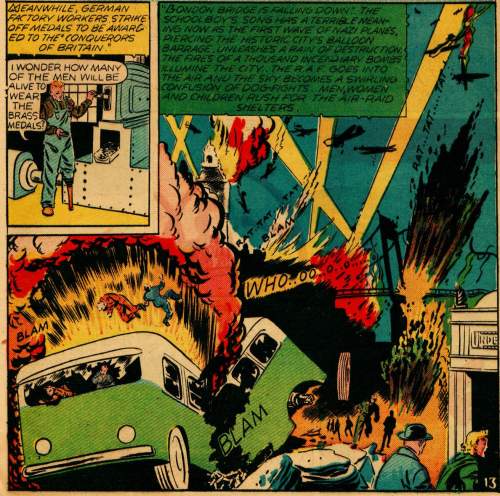
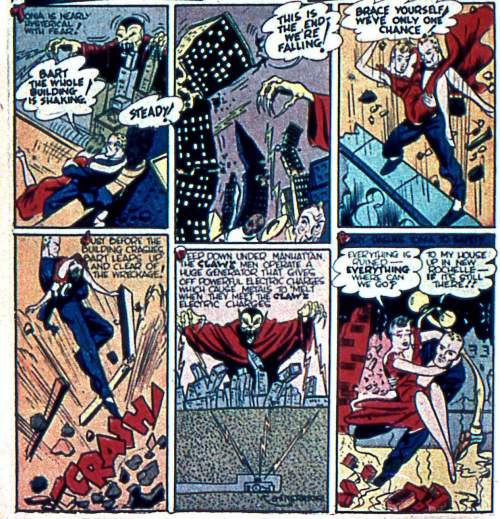
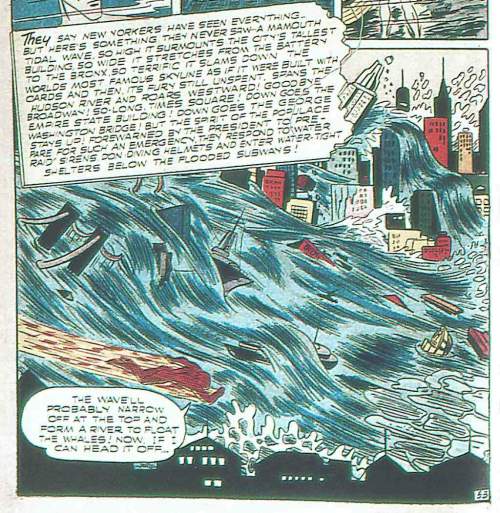
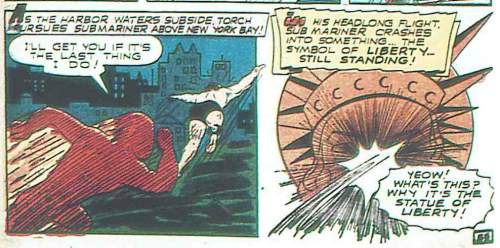
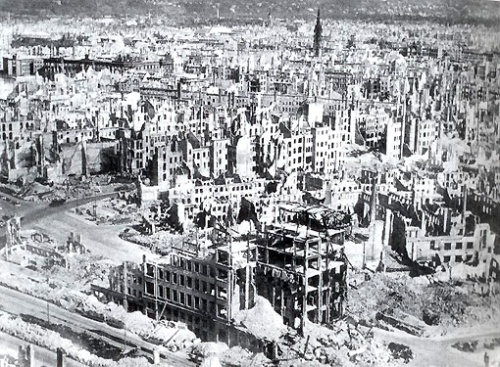

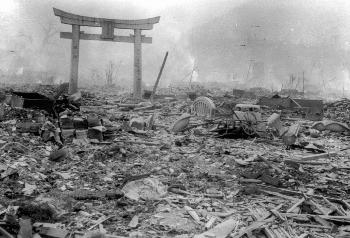
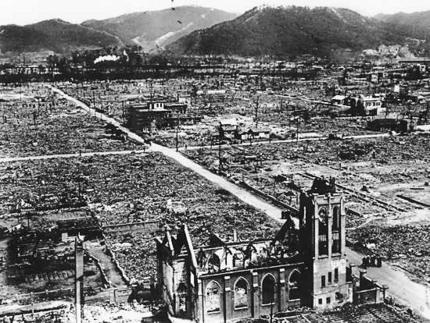





Jun 24, 2013 @ 01:41:34
Jun 24, 2013 @ 10:05:27
I note the word ‘mainland’ here: “no major destructive act of war occurred in the mainland United States in the years between 1865 and 2001” because of course, that leaves out Pearl Harbour. As a Brit, I find it a strange idea to treat Pearl Harbour as a special case just because it’s on Hawaii. We certainly took personal umbrage at the Nazi conquest of Guernsey.
Following some of your other arguments here about war and personal experience, they say that it was Chamberlain’s own war experience that underpinned his policy of appeasement. As he and Hitler were both veterans of the trenches, Chamberlain simply couldn’t believe that anyone would want to trigger another war, having lived through the reality of a global conflict at first hand. How wrong he was. But to understand appeasement it is important to see that Chamberlain was not looking at events from the safety of his armchair. He’d lived through the horror at first hand.
Jun 26, 2013 @ 07:23:29
There were several reasons why I exclude Pearl Harbor, but the primary one is that many Americans at the time didn’t even know what/where it was. While the Japanese attack angered most Americans instantly, the average citizen didn’t see the pics until weeks or months later, and it certainly didn’t have the same impact (no pun intended) as an entire city being leveled, or even large sections being destroyed (as the case with London).
Chamberlain is mentioned a coulpe of times by the people reminiscing in Terkel’s book. I was surprised to learn of an alternative way in which some people (Americans and Europeans) regard appeasement. There were people who viewed Germany as a buffer between Western Europe and Soviet Russia; absolutely nobody trusted Stalin, and Hitler was viewed by some as the lesser of the two evils. Their view was “give Hitler what he wants and let *him* fight Stalin”. (Which is ultimately what happened, but not in the way foreseen in the West.) It’s interesting to speculate about whether this was the case or whether appeasement was a result of a personal, visceral reaction to the potential for war.